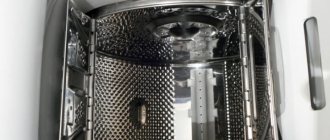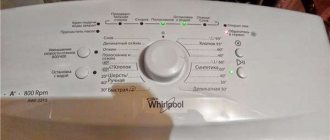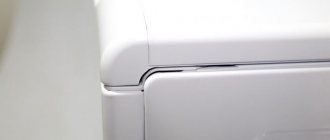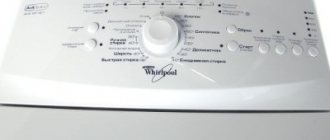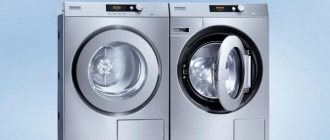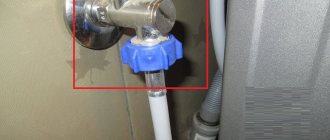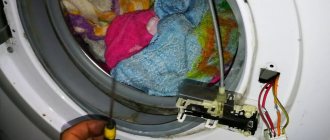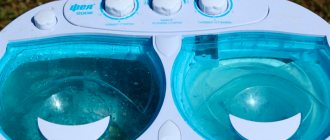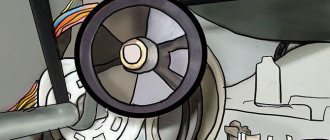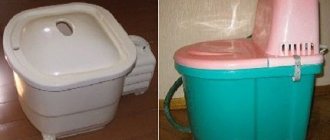Full-size washing machine Whirlpool FSCR 90420
+: 1. The tray with powder is washed perfectly, before rinsing it is completely clean without traces of powder (checked many times). As practice has shown, the reason for good rinsing is excellent washing powder made in Denmark. When using the Russian one, the result is bad, plus it’s easy to remove the tray and wash it, pour in our powder a little at a time. 2. Rinses clothes well, even in standard mode (there is no excessive “perfume”). 3. Quiet water supply system (the valve opens quite quietly, the sound of water supplied to the tray is non-irritating, quiet) 4. Low consumption of water and electricity. 5. The design is top notch, and it looks better in real life than in photographs. 6. Washing quality is good. 7. Warm rinse mode (the laundry is almost not wrinkled and is easy to iron; I think it completely replaces steam treatment and light ironing mode). 8. After washing, water does not collect in the lower part of the door seal and this place is dry after some time.
-: 1. Poor build quality. The top cover has play and knocks. When I was gluing strips of foam rubber on the bottom of the car, I noticed that the counterweight had sharp edges and large crumbs of concrete stuck to it, that is, in fact, they didn’t even wipe it with a rag, which I did myself by collecting a whole handful of these crumbs. The drum at the front (where the sealing rubber is) has a decent deviation from the circle (ovality). Electrical cables are wrapped in places with masking tape (paper tape with torn edges). All this indicates insufficient quality of production control and poor attention to detail. 2. High noise level. The noise of the pump is 3 times higher than the noise of washing and spinning, and is irritating. 3. Spin - wool is almost never spun at all, and often synthetics and cotton are only spun at low speeds. Looking at her suffering in trying to find the spin positions makes my heart bleed, 4. The top cover is smaller than the machine itself (there is no visor), when installed as close to the wall as possible, the gap between the cover and the wall is 7 cm. 5. It is not possible to turn off weighing and work according to standard time programs (regardless of weight), large increments of spin speed adjustment.
Review: To be honest, I did not expect such build quality from a car assembled in Italy at such a price. I would like to ask, gentlemen, if you have created a washing machine that actually washes and spins (without taking into account the work of the pump) a washing machine, is it really impossible to install one more valve and tee, the price of which is 1000 rubles, so that it really becomes quiet? As a result, its real volume (for me this is an important parameter) is no less than most cars with direct drive, which are 10,000 rubles cheaper (I won’t write down the models that children have to compare with, the manufacturers). The balancing algorithm is not optimal (the machine spins the drum too quickly, collecting laundry in one pile, after several attempts it often gives up. My old washing machine (15 years old) does this very smoothly, the laundry is distributed evenly and then sharply raises the speed and the drum beats during spinning, although it has less the gimbal is an order of magnitude simpler. If you bothered and made beautiful controls, then give people the opportunity to do more of their own choosing; after all, this is not a budget model. In general, you can be friends with it.
Whirlpool: A Washing Machine Journey
08.07.2016
Making the hero smaller in order to send him on an amazing journey is a technique used by the authors of many of our favorite books. Alice goes for a walk through Wonderland, Karik and Valya study the world of insects, and the Lilliputians study the workings of Gulliver's pocket watch. Let us also try to understand the details of the operation of the most interesting household appliance - the washing machine. ]Whirlpool[/anchor] provided us with this opportunity, and the object of our study was the new model of the Supreme Care series with front loading.
Whirlpool FSCR 90420 Washing Machine Supreme Care
Driven by curiosity, Alice looked down the rabbit hole, and we looked behind the back wall of the machine, where there is a removable lid
We see the bottom of the tank, some wires and terminals...
...and mentally shrinking and entering the space under the tank - rubber pipes and a mechanism reminiscent of a bicycle pump attached to the lower frame of the body
Next to it is a plastic box and multi-colored wires going to it.
We are in the drum of the machine: its stainless steel walls are perforated and have plastic linings
The washing machine tank is made of polypropylene - strong and durable plastic
A drum rotates inside the tank on a bearing.
All this is so interesting that it requires a more detailed consideration of each of the elements of the machine. Let's start with the tank: this largest part after the body has a volume of 58 liters and is made of polypropylene - strong and durable plastic. A stainless steel drum is placed inside the tank at the factory, the drum axis is secured to a bearing, which is pressed into the rear wall of the tank, after which the two halves of the tank are fastened together forever, that is, until the end of the machine’s service life. The drum of the Whirlpool FSCR 90420 washing machine is designed to load 9 kg of laundry and spins at a speed of up to 1400 rpm.
Through the perforation holes, which we saw while inside the tank, water flows into the laundry, and plastic grips lift the laundry as the drum rotates. The shape, size and number of holes, as well as the configuration of the grips are all carefully thought out and proven in hundreds of factory tests. Everything is subordinated to one task: to make washing as efficient as possible and damage to the fabric structure to a minimum.
Counterweights, shock absorbers and suspension springs
The tank suspension system consists of two springs at the top and three shock absorbers at the bottom, and the stiffness of the springs and the characteristics of the shock absorbers are selected to maximally compensate for the vibrations that occur when the laundry drum rotates. And in order to prevent the washing machine from “jumping” around the bathroom during operation, massive counterweights made of dense concrete are attached to the tank - one on top, the other below, on the front half of the tank.
A fragment of technical documentation for a washing machine - one of the “exploded views”
When servicing a washing machine, service specialists use technical documentation - a multi-page document, which, in particular, contains the so-called “exploded views”: images illustrating the relative position of its parts.
Transport bolts
An important design element is the transport bolts. They attach the tank-drum assembly to the body to prevent it from moving when transporting the machine. When the machine is installed in its place, the transport bolts must be removed - otherwise, after turning on, it will begin to jump.
Direct drive motor and drum rear wall
Direct drive motor
Bearing and drum axle
The new generation of Whirlpool washing machines do not have pulleys or drive belts: the drum is driven by an inverter-controlled direct drive electric motor that fits directly onto its axle. The absence of transmission elements makes the machine drive compact, significantly reduces noise and vibration levels, allows optimizing energy consumption, and also makes the machine more reliable - because due to friction on the drum pulley, the traditional belt gradually wears out and requires replacement from time to time. Whirlpool's direct drive system is called Zen for good reason: its quiet operation will not disturb you, even if you are immersed in meditation. Moreover, the spin cycle of washing machines in this series is the quietest on the market: the noise level is only 76 dB.
We remove the heating element (heater)
Washing machine heating element
Those terminals that we saw at the beginning, looking into the service hatch, were connected to a heating element (heating element) made of stainless steel. It is located at the bottom of the tank and heats the water to the required temperature, which, by the way, it measures itself - pay attention to the small temperature sensor tablet near the sealing gasket.
Level relay
An inconspicuous but very important element of the washing machine is a pressure switch or level switch, which is connected to the tank with a rubber tube. The pressure of the water column in the tank is transmitted to the membrane of this device, the deformation of which triggers the contacts of the electrical circuit: enough water has accumulated, which means it’s time to stop filling. By the way, in this regard, the Whirlpool FSCR 90420 washing machine is very economical: it consumes 9300 liters of water per year, based on 220 washes using the standard “Cotton” program at 60 °C and 40 °C at full and partial load.
Loading hatch and rubber seal (cuff)
The laundry is loaded into the machine through a hatch with a glass lock and an electromagnetic lock that locks while the machine is running. Pay attention to the shape of the glass: it also eliminates any impact on the laundry that could damage the fabric.
Detergent dispenser, inlet hose and solenoid valve
Water enters the machine when the solenoid valve opens - and it closes, as we already know, after the level switch is activated. Rinsing the detergent from the dispenser compartments, the water enters the tank in the form of a washing solution.
Elements of the drain system
Drain pump and trap filter
Water must not only be poured into the tank, but also drained into the sewer after finishing the wash. This task is performed by the drain pump located under the tank of the machine. It is equipped with a catch filter that traps small objects - buttons, paper clips, toothpicks and other things that the owner of the car forgot to remove from his clothing pockets before washing. To access the filter, you need to remove the panel in the base of the machine.
Ball valve Eco Ball
This part of the machine looks frivolous in appearance - some kind of ball, some kind of rubber tube. In fact, this device - the Eco Ball, which separates the machine's water-filled tank from the drain pump - is very important from an environmental point of view. Thanks to it, undissolved particles of washing powder remain in the tank until completely dissolved and do not merge with the water into the sewer.
6th Sense Electronic Control Board
It's time to find out - what's in that plastic box? Who commands all the elements of the machine? Who gives the signal to the heating element to start heating the water, to the electric motor to gain speed, to the pump to drain the water? In the FSCR 90420 washing machine, an electronic control system, which Whirlpool calls 6th Sense (“sixth sense”), is responsible for all this. It automatically determines the amount of laundry loaded (you ask - how? Yes, using the same level switch, which “reports” how quickly the load absorbs water, and, therefore, how large it is), calculates the cycle duration and optimizes the consumption of water and electricity . And it does this very successfully: the washing machine has an A+++ energy consumption class according to European Union standards.
Cyclogram of machine operation (Cotton program, 40°C)
As an example of the coordinated operation of all elements of the machine, we present a fragment of the cyclogram on the Cotton program, 40°C. At stage A (pre-wash), the electric motor (line 1) begins to perform reverse rotations at a speed of 40-60 rpm, water is poured into the tank (line 2), and it is heated to 30°C (line 3). Immediately and until the end of the wash, the lock of the loading hatch is locked (line 4), and the pump (line 5), quickly draining the remaining water from the system after turning on the machine, is activated again after the completion of the pre-wash, and then each subsequent stage.
Then comes the enzyme wash phase B with the water heated to 35°C, the main wash phase C at 40°C, two rinses D1 and D2 are performed, and at the end - spin E. At all stages, the elements of the machine work consistently and clearly, like a clock.
Control Panel
All these actions, of course, remain invisible (and, as we already know, practically inaudible) for the user. He only needs to load laundry and detergent into the machine, and then select the desired washing program from the control panel. Well, we figured out how this program is executed by looking inside the machine.
